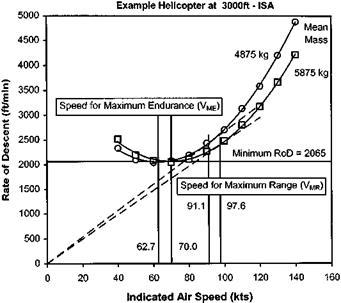Speeds for maximum range and endurance
Since the variation of RoD in autorotation with airspeed resembles a power curve it is possible to use it to identify speeds for maximum range or endurance. In an autorotative descent the helicopter will obviously remain aloft longer if it is flown at the speed that results in the lowest rate of descent. Therefore VME is the ‘bucket speed’ obtained from the performance curve, see Fig. 2.33. An autorotative performance curve typically presents RoD versus indicated airspeed. If the pitch attitude of the aircraft during the descent is not excessive and the pitot-static system is free of significant errors it can be assumed that the curve presents two velocities along orthogonal axes (forward advance and rate of descent). Consequently the slope of a line from the origin that intersects the performance curve represents the angle of glide and therefore the speed that gives the minimum angle (that is tangential to the performance curve) will be VMR, the ‘range speed’ in autorotation, see Fig. 2.33.
2.13 FLARE CHARACTERISTICS AND ENGINE-OFF LANDINGS
By examining the autorotative performance of a typical helicopter and noting the conditions leading to entry into vortex ring it has been possible to show that engine – off flight can be conducted safely at all airspeeds provided the rotor speed required falls within the power-off range for the rotor. In fact stable autorotations are possible even in vertical flight but these often result in high rates of descent. High RoDs do not present a problem provided they allow sufficient time for the pilot to select a suitable landing site and compose himself for the ensuing engine-off landing. In theory,
|
Fig. 2.33 Autorotative performance speeds. |
if the problems of vortex ring are ignored, it is possible to autorotate vertically and by applying increased collective pitch, at the correct moment, arrest the sink rate to land with zero ground speed. However, from the typical autorotative performance detailed above it is more likely that the pilot will be descending at VME. Although he may have opted to accelerate to VMR and/or droop the rotor, to increase his time aloft or cover ground more efficiently, he will inevitably reselect VME and raise the rotor speed before attempting a landing. The raised NR stores more energy for use in the landing phase of the manoeuvre.












